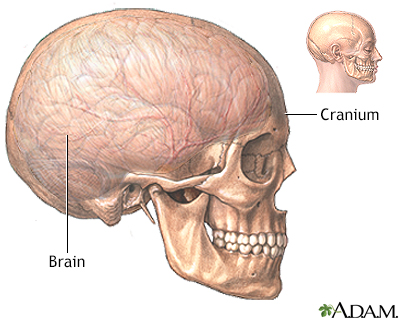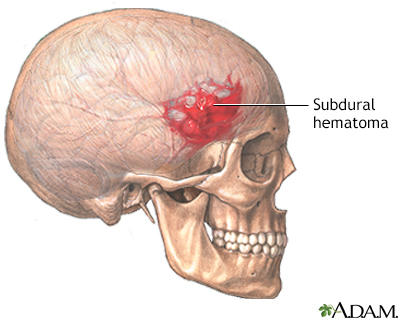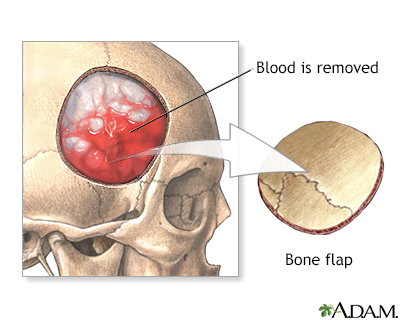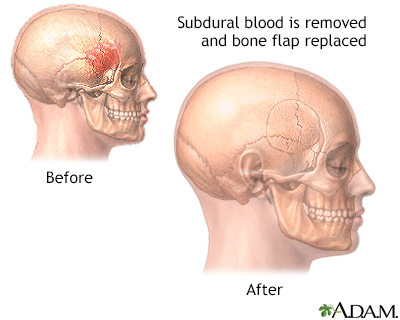Brain surgery
Craniotomy; Surgery - brain; Neurosurgery; Craniectomy; Stereotactic craniotomy; Stereotactic brain biopsy; Endoscopic craniotomyBrain surgery is an operation to treat problems in the brain and surrounding structures.
Description
You may be awake or asleep during this procedure which is called a craniotomy. An awake craniotomy is done when your surgeon works near critical areas of your brain, such as the language area.
Before surgery, the hair on part of the scalp is shaved and the skin is cleaned. The surgeon makes a cut through the scalp to expose the bone (skull). The location of this cut depends on where the problem in the brain is located.
The surgeon uses a high-speed drill and saw to cut a portion of the bone (a bone flap) to access the brain.
In some cases, the surgeon may create a smaller incision and use a tube equipped with a light and camera, known as an endoscope. The surgery is done by inserting tools through the endoscope. A computerized navigation system that generates 3D images from an MRI or CT scan of your brain helps the surgeon locate the specific area to be operated on.
MRI
A head MRI (magnetic resonance imaging) is an imaging test that uses powerful magnets and radio waves to create pictures of the brain and surrounding...

CT
A computed tomography (CT) scan is an imaging method that uses x-rays to create pictures of cross-sections of the body. Related tests include:Abdomin...

During surgery, your surgeon may:
- Clip off an aneurysm to prevent bleeding
Aneurysm
An aneurysm is a weak area in the wall of a blood vessel that causes the blood vessel to bulge or balloon out. When an aneurysm occurs in a blood ve...
 ImageRead Article Now Book Mark Article
ImageRead Article Now Book Mark Article - Remove abnormal blood vessels
- Remove a tumor or a piece of tumor for a biopsy
Tumor
A primary brain tumor is a group (mass) of abnormal cells that start in the brain.
 ImageRead Article Now Book Mark Article
ImageRead Article Now Book Mark ArticleBiopsy
A biopsy is the removal of a small piece of tissue for lab examination.
 ImageRead Article Now Book Mark Article
ImageRead Article Now Book Mark Article - Remove abnormal brain tissue
- Drain blood or an infection
- Free a nerve
- Take a sample of brain tissue to help diagnose nervous system diseases
- Put a tube (shunt) in the cavities of your brain to remove excess fluid
The bone flap is usually placed back at the end of the surgery, using small titanium plates to hold it in place. These plates are MRI compatible. This brain surgery is called a craniotomy.
If a smaller hole (burr hole) was made, your surgeon may cover it with a metal plate.
The bone flap may not be put back if your surgery involved a tumor or an infection, or if the brain was swollen. This brain surgery is called a craniectomy. The bone flap may be kept in a freezer or placed under the skin of your abdomen and put back during a future operation.
The time it takes for the surgery depends on the problem being treated.
Why the Procedure Is Performed
Brain surgery may be done if you have:
- Brain tumor
- Bleeding (hemorrhage) in the brain
-
Blood clots (hematomas) in the brain
Blood clots
Blood clots are clumps that occur when blood hardens from a liquid to a solid. A blood clot that forms inside one of your veins or arteries is calle...
 ImageRead Article Now Book Mark Article
ImageRead Article Now Book Mark Article - Weaknesses in blood vessels (brain aneurysm repair)
Brain aneurysm repair
Brain aneurysm repair is surgery to correct an aneurysm in or near the brain. This is a weak area in a blood vessel wall that causes the vessel to b...
Read Article Now Book Mark Article - Abnormal blood vessels in the brain (arteriovenous malformations [AVMs], cavernous malformation)
- Damage to tissues covering the brain (dura)
- Infections in the brain (brain abscesses)
Brain abscesses
A brain abscess is a collection of pus, immune cells, and other material in the brain, caused by a bacterial or fungal infection.
 ImageRead Article Now Book Mark Article
ImageRead Article Now Book Mark Article - Severe nerve or face pain (such as trigeminal neuralgia, or tic douloureux)
Trigeminal neuralgia
Trigeminal neuralgia (TN) is a nerve disorder. It causes a stabbing or electric shock-like pain in parts of the face.
 ImageRead Article Now Book Mark Article
ImageRead Article Now Book Mark Article - Skull fracture
- Pressure in the brain after an injury or stroke
Stroke
A stroke occurs when blood flow to a part of the brain stops. A stroke is sometimes called a "brain attack. " If blood flow is cut off for longer th...
 ImageRead Article Now Book Mark Article
ImageRead Article Now Book Mark Article -
Epilepsy
Epilepsy
Epilepsy is a brain disorder in which a person has repeated seizures over time. Seizures are episodes of uncontrolled and abnormal electrical activi...
 ImageRead Article Now Book Mark Article
ImageRead Article Now Book Mark Article - Certain brain diseases (such as Parkinson disease) that may be helped with an implanted electronic device
Parkinson disease
Parkinson disease results from certain brain cells dying. These cells help control movement and coordination. The disease leads to shaking (tremors...
 ImageRead Article Now Book Mark Article
ImageRead Article Now Book Mark Article -
Excess cerebrospinal fluid in the cavities of your brain (hydrocephalus)
Hydrocephalus
Hydrocephalus is a buildup of fluid inside the skull that leads to the brain pushing against the skull. Hydrocephalus means "water on the brain. "...
 ImageRead Article Now Book Mark Article
ImageRead Article Now Book Mark Article
Risks
Risks for anesthesia and surgery in general are:
- Reactions to medicines
- Problems breathing
- Bleeding, blood clots, infection
Possible risks of brain surgery are:
- Problems with speech, memory, muscle weakness, balance, vision, coordination, and other functions. These problems may last a short while or they may not go away.
- Blood clot or bleeding in the brain.
-
Seizures.
Seizures
A seizure is the physical changes in behavior that occurs during an episode of specific types of abnormal electrical activity in the brain. The term ...
 ImageRead Article Now Book Mark Article
ImageRead Article Now Book Mark Article - Stroke.
-
Coma.
Coma
Decreased alertness is a state of reduced awareness and is often a serious condition. A coma is the most severe state of decreased alertness from whi...
Read Article Now Book Mark Article - Infection in the brain, wound, or skull.
- Brain swelling.
- The need for more surgery.
Before the Procedure
Your surgeon will examine you and may order lab and imaging tests.
Tell your surgeon or nurse if:
- You are or could be pregnant
- You are taking any medicines, including medicines, drugs, supplements, or herbs you bought without a prescription
During the week before your surgery:
- You may be asked to temporarily stop taking medicines that keep your blood from clotting. These medicines are called blood thinners. This includes over-the-counter medicines and supplements such as aspirin, ibuprofen (Advil, Motrin), naproxen (Aleve, Naprosyn), and vitamin E. Many prescription medicines are also blood thinners.
- Ask your surgeon which medicines you should still take on the day of surgery.
- Try to stop smoking. Smoking can slow healing after your operation. Ask your surgeon for help.
- Your surgeon or nurse may ask you to wash your hair with special shampoo the night before surgery.
On the day of surgery:
- Follow instructions about when to stop eating and drinking.
- Take the medicines your surgeon told you to take with a small sip of water.
- Arrive at the hospital on time.
After the Procedure
After surgery, you will be closely monitored by your health care team to make sure your brain is working properly. The surgeon or nurse may ask you questions, shine a light in your eyes, and ask you to do simple tasks. You may need oxygen for a few days.
The head of your bed will be kept raised to help reduce swelling of your face or head. The swelling is normal after surgery.
You'll be given medicines to relieve pain.
You'll usually stay in the hospital for 3 to 7 days. You may need physical therapy (rehabilitation).
After you go home, follow any self-care instructions you're given.
Self-care instructions
You had surgery on your brain. During surgery, your surgeon made a surgical cut (incision) on your scalp. A small hole was then drilled into your s...
Read Article Now Book Mark ArticleOutlook (Prognosis)
How well you do after brain surgery depends on the condition being treated, your general health, which part of the brain is involved, and the specific type of surgery.
References
Patterson JT. Neurosurgery. In: Townsend CM Jr, Beauchamp RD, Evers BM, Mattox KL, eds. Sabiston Textbook of Surgery. 21st ed. St Louis, MO: Elsevier; 2022:chap 68.
Tate MC, Duffau H. Awake craniotomy and intraoperative mapping. In: Winn HR, ed. Youmans and Winn Neurological Surgery. 8th ed. Philadelphia, PA: Elsevier; 2023:chap 156.
Zada G, Attenello FJ, Pham M, Weiss MH. Surgical planning: an overview. In: Winn HR, ed. Youmans and Winn Neurological Surgery. 8th ed. Philadelphia, PA: Elsevier; 2023:chap 18.
-
Before and after hematoma repair - illustration
Brain surgery may be needed in treatment of subdural hematoma to remove blood and to decrease intracranial pressure. The outcome of the surgery depends on the source, severity, and location of the problem.
Before and after hematoma repair
illustration
-
Craniotomy - series
Presentation
-
Before and after hematoma repair - illustration
Brain surgery may be needed in treatment of subdural hematoma to remove blood and to decrease intracranial pressure. The outcome of the surgery depends on the source, severity, and location of the problem.
Before and after hematoma repair
illustration
-
Craniotomy - series
Presentation
Review Date: 1/13/2025
Reviewed By: Luc Jasmin, MD, Ph.D., FRCS (C), FACS, Department of Neuroscience, Guam Regional Medical City, Guam; Senior Advisor at Elevance Health, Department of Surgery, Johnson City Medical Center, TN; Senior advisor at Elevance Health Department of Maxillofacial Surgery at UCSF, San Francisco, CA. Review provided by VeriMed Healthcare Network. Also reviewed by David C. Dugdale, MD, Medical Director, Brenda Conaway, Editorial Director, and the A.D.A.M. Editorial team.








